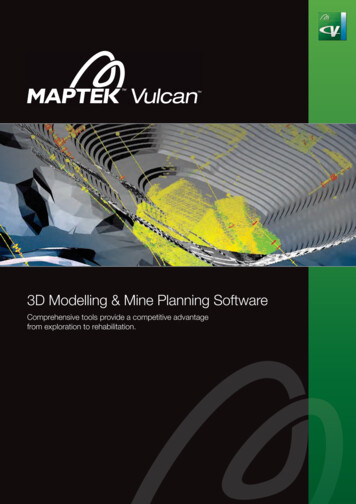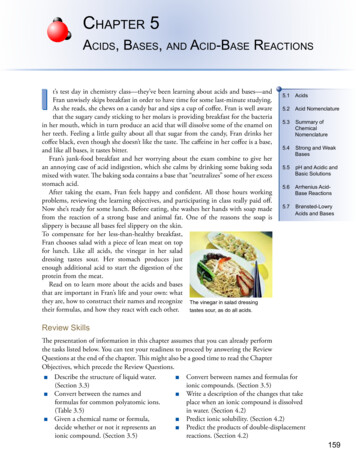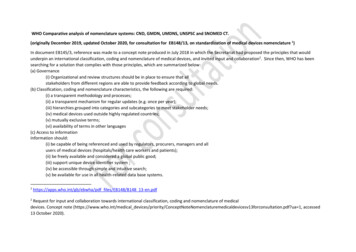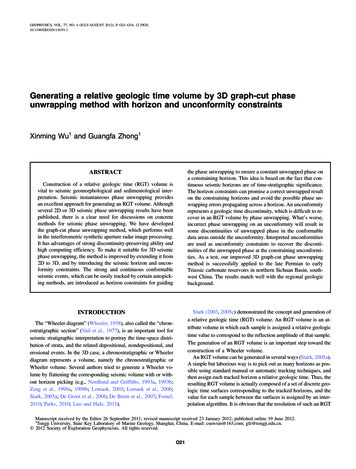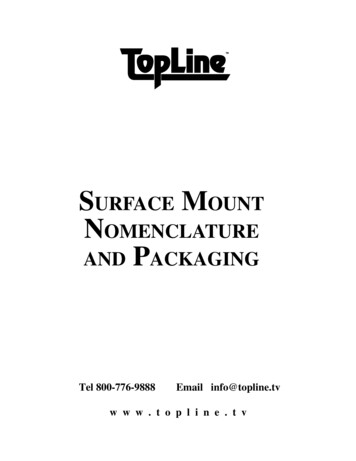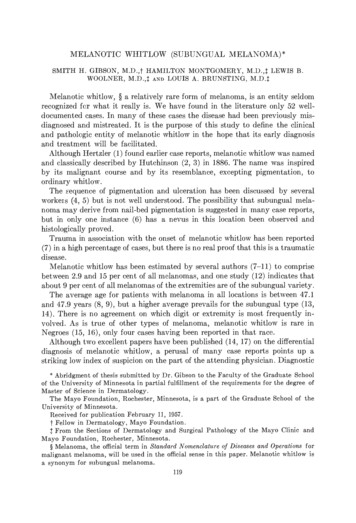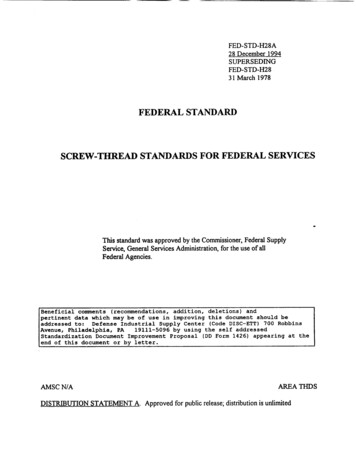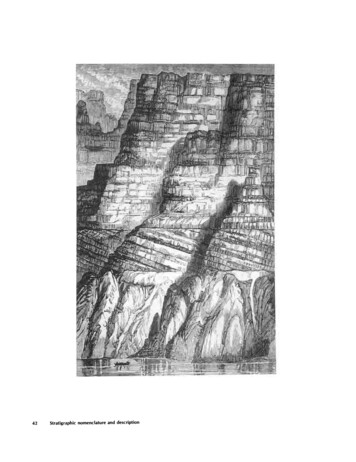
Transcription
42Stratigraphic nomenclature and description
STRATIGRAPHIC NOMENCLATURE AND DESCRIPTIONTHE ROCKS OF THE UNITED STATES areclassified for mapping purposes by a complexscheme of named material and temporal or geologictime terms. Most of the time terms (for example,Cretaceous) were defined and first used by Europeangeologists and have since been accepted by geologistsin most other parts of the world. As parts of theUnited States were mapped geologically, localdivisions of rocks were recognized and named inindividual study areas. Lithology, rather than faunalassemblages, is the basis of this local classification,principally to aid in recognizing and mapping theunits so as to summarize the geologic history of eacharea and evaluate the geologic resources.The stratigraphic units discussed in this chapter areclassified into categories and ranks. The first categoryincludes "material units" that are called lithostratigraphic, lithodemic, allostratigraphic, magnetopolarity, or pedostratigraphic units in the North AmericanStratigraphic Code (NASC) by the North AmericanCommission on Stratigraphic Nomenclature (1983, p.852). Lithostratigraphic unit is a term much used outside the United States (International Subcommissionon Stratigraphic Classification). Some lithostratigraphic units may have faunal boundaries that coincide with lithologic ones. Uncertainties in interpretingoriginal definitions of lithologic units, or in correlatingthem with units near or far, have led to many localgeologic names and to increasing numbers of unitseach year. The second category is the "temporalunits" which are chronostratigraphic, geochronologic,geochronometric, polarity-chronostratigraphic,polarity-chronologic, and diachronic units.The term "geologic name" has evolved in its application by the Survey since the late 19th century. Atthat time the Geologic Names Committee (or GNC)not only considered names for lithologic units and thegeologic age terms applied to them but also adjudicated (1) the correct use of petrologic terms andstructural terms and their symbols, and (2) the aptness of colors, patterns, and all other symbols used ongeologic maps and reports published by the Survey.The term "geologic name" as used in STA is thename of a defined rock body, or the local name applied to a mapped rock unit. The map unit is recognized by its lithologic content (homogeneous orheterogeneous) and its boundaries. It (1) is assigned aplace within the geologic age sequence, (2) has astratigraphic rank, and (3) is mappable. The unit maybe formal: that is, it may be defined by standards ofthe presently (1983) accepted code, or may have beendefined under a previously accepted (1933, 1961,1970) code, or it may have been named and found!useful before the writing of any code and has gainedacceptance through common usage.Formal geologic names are those that have beendefined according to the standards of the time inwhich they were introduced. Units named and founduseful before 1983, the publication date of the mostrecent code, are not discarded just because they werenot defined according to current standards. Map w i t smay also be informal and not defined by any standard. Any author using informal names should clearlydistinguish them from formal names.GEOLOGICNAMESUNITSAND THEBecause the Geological Survey examines variousaspects of geology throughout the United States, allits publications adhere to broadly uniform proceduresin dealing with the nomenclature and classification ofrock masses. The responsibility for this conformity isdelegated to a group of Survey geologists assigned toone of the Geologic Names Unit (GNU) staffs inReston, Va., Denver, Colo., and Menlo Park, Calif.,under the technical guidance of the Geologic NamesCommittee (GNC).The Geologic Names Committee was organized in1899 to consider all names of geologic formations andother divisions of rock classifications, to determinewhether the names comply with nomenclature used inpreviously published Survey reports, and to reconnmend policy on stratigraphic nomenclature. Membersof the committee are appointed by the Chief Geologistand are responsible to him through authority delegated by the Director. The members of the GNC arechosen for their experience and knowledge in thescience. In addition to the chairman, the committeecurrently consists of geologists chosen from the threecenters (Reston, Va., Denver, Colo., and Menlo Park,Calif .).The Geologic Names Committee defines andrecommends policy and rules governing stratigralphicnomenclature and classification in all manuscript ;andStratigraphic nomenclature and description43
maps originating in the U.S. Geological Survey andconcerning the geology of the United States. Theactions of GNC apply whether these reports and mapsare to be published by the Survey or by an outsideorganization, and whether they result wholly or partlyfrom the work of Geological Survey employees.Except for papers intended as abstracts for talks orfor some papers in the Open-File Report series, everymanuscript that is written by a Survey author andthat contains stratigraphic names is read andapproved by a member of a GNU staff before itspublication is authorized by the Director. Technicalproblems, such as differences of opinion amongSurvey authors or nonconformance to Survey policyor to the North American Stratigraphic Code, arereferred to the committee for recommended solution.The basis of the committee's action is the NorthAmerican Stratigraphic Code (the code) and itspredecessors. The North American Commission onStratigraphic Nomenclature currently has more than20 members chosen from 8 geological societies andState and Federal surveys in North America:American Association of Petroleum Geologists,Geological Society of America, Geological Survey ofCanada, Geological Association of Canada, CanadianSociety of Petroleum Geologists, U.S. GeologicalSurvey, Association of American State Geologists,Asociaci6n MBxicana de Ge6logos Petroleros, SociedadGe6logica Mexicans, and Instituto de Geologia de laUniversidad NacionAl Autdnoma de MBxico. Severaleditions of the code have been printed since the firstone was prepared in 1933; the most recent edition,published in 1983, is for sale by the American Association of Petroleum Geologists, Box 979, Tulsa, OK74101. Survey authors can get copies from one of theGNU offices. Amendments and additions to the codeare proposed from time to time. They are publishedas Notes or Reports, usually in the American Association of Petroleum Geologists Bulletin. Before proposed changes are adopted by the commission forinclusion in the code, comments and discussions areinvited from the geologic profession.The classification and nomenclature of rock units inmanuscripts resulting from cooperative investigationswith State geological surveys, or other outside organizations or individuals, may follow the scheme of thecooperating organization, with an appropriate statement of explanation. Any classification scheme usedmust have been described in a published report or thedescription must be included in the proposed report.Although the Geologic Names Units do not judgethe validity or use of any name outside the publications of the U.S. Geological Survey, GNU records ofstratigraphic names do include all formal geologic44Geologic Names Units and the Geologic Names Committeenames of the United States as they are used inpublications. These records are available for referenceat all times to all geologists inside and outside theSurvey. A geologist who plans to name a forinalstratigraphic unit may reserve the geographic namewith one of the GNU staffs in Denver, Menlo Park,or Reston so that other geologists who may inquireabout the name can be informed of the first author'sintention. If that geographic name is already reserved,an author then has an opportunity to select anothersuitable name. Proposals for new nomenclature andrevisions of existing nomenclature are made inreports that are published in recognized scientificmediums as defined by the 1983 code. Proposals willbe more quickly accepted if they are discussed withpeers who work for State surveys, academia, andindustry as well as with those who work for theSurvey during the preparation of a report.In reviewing manuscripts, GNU staff membersdepend on a file of annotated records, on the framework of policy and objectives as set forth by the GNCand its chairman, and on the North American Stratigraphic Code. Each staff member is expected to bringsignificant departures from these guides to the attention of the local committee members or to the chairman of the committee so that problems may beresolved expeditiously at a local level. The full committee formulates general policy and advises onspecific nomenclatural problems.CONFORMANCETO THE CODEA N D MODIFICATIONTOSTRATIGRAPHIC UNITSFour codes (Ashley and others, 1933; AmericanCommission on Stratigraphic Nomenclature, 1.961,1970; North American Commission on StratigraphicNomenclature, 1983) have been written to provideguidance to scientists using stratigraphic terminologyand to provide the profession with standards fornaming, defining, and classifying "rock units and theirspatial and temporal relations" (North American Commission on Stratigraphic Nomenclature, 1983, p. 847).Each code reflects advances in scientific knowledgeand technology at the time of its preparation. Somerecommendations in the 1983 code are similar tothose drawn up in 1903 and published in the :24thAnnual Report of the Director. Parts of the 1983code serve researchers who work with discontinuitybounded sequences (allostratigraphic units), withintrusive, deformed, and highly metamorphosed rocks(lithodemic units), and with rocks distinguished byremanent-magnetic properties (magnetostratigraphic
units). Pedostratigraphic units replace the classification termed "soil-stratigraphic units" in the 1961and 1970 codes. The term "lithostratigraphic unit"replaces the term "rock-stratigraphic unit" of the1961 and 1970 codes.Accuracy and clarity are the two main objectives inall written and graphic presentations of stratigraphicdata. A common procedure of the GNU staff and onerecommended to authors and technical reviewers ofstratigraphic reports is to place the geologic-mapexplanation and the stratigraphic chart alongside thegeology section of the text. As the geology section isread, it can easily be compared with the other twoparts. An assessment may be made at that time concerning stratigraphic changes and conformance withthe code. Questions that arise may be addressed tothe GNU reviewer and resolved before turning thereport in for review.The stratigraphic nomenclature record file is updated whenever a report that adequately explains thereasons for a stratigraphic change is submitted forpublication. Obviously, many of the changes added tothe file as accepted by the Survey are those recommended by Survey authors on the basis of their work.Because the Survey prefers to have a uniform nomenclature for any one area, a person proposing a changeshould discuss it with a review staff member and withpeers working near the report area before the reportis completed. However, preference for uniformnomenclature does not preclude differences of interpretations as long as the differences of opinion arerecognized and clearly documented.The primary responsibility of the GNU staff is toensure conformance to the code and proper use offormal stratigraphic nomenclature. When necessary,biostratigraphic nomenclature is checked by specialistsin the Survey's Branch of Paleontology and Stratigraphy, and isotopic dates are reviewed by specialistsin the Branch of Isotope Geology. GNU staff members carefully read the comments by technical reviewers of all major stratigraphic reports. In proposing ormodifying nomenclature, authors should give carefulattention to previous and current work of others, bothwithin and outside the Survey. Proposals will be morequickly accepted if they are discussed with peers.The published lexicon volumes should not be quotedas the authority in stratigraphic discussions; referenceshould be made to the original article upon which thelexicon data are based.(NACSN, 1983, p. 849). The terminology applied totemporal units is used beyond the local area; in fact,the boundaries of most temporal units have beenaccepted by international agreement. The terms"time-stratigraphic" and "geologic time" units of the1960 code are designated only as chronostratigraphicand geochronologic units respectively in the 1983code.Units of time may be expressed in years (y or yr) asmy, m.y., m.yr. for millions of years and as by, b.y.,b.yr. for billions of years for an interval of time; or inannum as ka for kilo-annum, Ma for mega-annum, Gafor giga-annum for ages. For example, boundaries ofthe Late Cretaceous Epoch currently are calibrated at66 Ma and 96 Ma, but the interval of time represented by this epoch is 30 m.y. (art. 13c of the oode).Chronostratigraphic units. These units designatethe position of the material unit in geologic time.Examples of chronostratigraphic terms (listed in orderof decreasing stratigraphic rank) are PhanerozoicEonothem, Mesozoic Erathem, Cretaceous System,Upper Cretaceous Series, Maastrichtian Stage.Geochronologic units. Geochronologic units (listedin order of decreasing stratigraphic rank) are used todesignate the uge of the material units within geologictime, such as Phanerozoic Eon, Mesozoic Era, Cretaceous Period, Late Cretaceous Epoch, and Maastirichtian Age. Boundaries used for geochronologic termscorrespond to the time span of a chronostratigraphicunit.Geochronometric units. Rocks older than 570 Maare divided into geochronometric units (fig. 15). !rheirboundaries are usually internationally agreed-uponages. No type localities have been designated.Examples are Archean Eon, Late Archean Era.Polarity-chronostratigraphic units. The reco'gnized polarity-chronostratigraphic units (listed inorder of increasing age) are Brunhes, Matuyama,Gauss, and Gilbert.Polarity chronologic and diachronic units are additions to the 1983 code; no named units have yet beendesignated.TEMPORALAND RELATEDUNITSFORMALNAMESTemporal units are used "to establish a timeframework for the discussion of geologic history"The 1983 code carefully lists the requirements for aformal geologic unit name (article 3) and states thatLithostratigraphic, lithodemic, allostratigraphic,magnetopolarity, and pedostratigraphic units are encompassed in the general term "stratigraphic unit" inthis text section. References to all articles are thoseof the 1983 code.Formal names45
the first letter in all words used in the formal geologic unit name is capitalized (arts. 3-16, 22-47,55-60 of the code).New NamesAuthors planning to define new formal lithostratigraphic, lithodemic, allostratigraphic, magnetostratigraphic, or pedostratigraphic units should read theappropriate articles of the code that list the requirements for new names. All formal geologic names arecompound; they consist of a geographic name and arank term or descriptive term. The geographicname-a river, town, or other permanent geographicfeature-is at or near the place where the geologicunit is typically developed. The geographic name for anew unit should be referable to an established geographic name printed on a topographic map or on aState map, county map, Forest Service map, or othermap that shows names approved by a national boardfor geographic names (art. 7a of the code). In theUnited States, the appropriate board is the Board onGeographic Names (p. 83). The author should determine that the geographic name has not been used foranother previously named stratigraphic unit.If stratigraphic units are to be named in areaswithout named geographic features, a new geographicname can be proposed through the Board on Geographic Names. Instructions and application forms forproposing new geographic names are available, andthese forms should be completed by the author at anearly stage in the preparation of a report.The report in which the new stratigraphic name isdefined should contain 11basic elements:1. Intent to designate or modlfy a formal unit2. Designation of category and rank of unit3. Selection and derivation of geographic name4. Specification of type locality, section, or area(preferably on a geologic map with a topographicbase showing location and mappability of units)5. Description of unit6. Definition of boundaries7. Historical background8. Dimensions, shape, and other regional aspects9. Geologic age10. Correlations11. Genesis (where applicable)Previously Defined NamesWhen using stratigraphic names that have not beenadopted by the Survey or that have a complex historyof controversial or varied use, authors should includecitations that clanfy their use of the name. The namecould be referred to, for example, as the Deer ValleyLimestone of Flint (1962) or Deer Valley Limestone(Flint, 1962), or an alternative statement could read,"Flint in 1962 named the Deer Valley Limestone."To adopt a stratigraphic name that has been definedpreviously but has not been evaluated by the Surveyfor compliance with the code, an author should (a)confirm that the 11 elements listed above are attributed to the unit; if they are not, the author shouldcomplete them and include a statement of intent, suchas, "This unit, named by Smith in 1970, is hereadopted," or "here accepted," or "here used" and(b) briefly summarize Smith's description of thestratigraphic unit.Modification of Existing NamesExisting formal names may be modified if evidencefor a change is presented in a published report. Aname is said to be revised if the boundary of the unitis changed slightly, if stratigraphic rank is changed, ifthe unit is reassigned to another unit, if a unit isplaced in a unit of higher rank, or if a unit is dividedinto units of lesser rank. The rank or descriptive termmay be changed locally or regionally, for example,from "sandstone" to "formation." An abandonedterm should be replaced by another stratigraphicname that may or may not be formal; an abandonedterm may be reinstated. A change in age designationcould result from new data, such as fossil identifications, isotopic ages, or a physical correlation with adated unit or with a unit between two dated units.The areal limits of a unit may be extended by surfaceor subsurface mapping. The following modificationsare listed in alphabetical order.Abandoned names (art. 20 of the code)If an author proposes to abandon the name ofa stratigraphic unit, the author should state why(improperly defined or obsolete) and should give thename of the unit or units replacing the abandonedname. The old name is then referred to in subsequentreports as being obsolete, abandoned, or of formerusage, or it is preceded by a dagger. An author maybe more prudent to not use a term rather than abandon it, for other workers mapping at different scales"These requirements apply to subsurface and offmayfind the term useful. By stating the reasons forshore, as well as exposed units" (North Americannotusinga term, the author will allow time to deterCommission on Stratigraphic Nomenclature, 1983, art.ifsubsequentworkers agree that the name ismine3, p. 851). None of these elements can be used as ainvalid(art.5a).Theword "abandoned" should not besingle valid criterion for establishing a new name.46New names
applied to the name of a unit that is being areallyrestricted. An abandoned name is understood to beabandoned everywhere, including its type section,locality, or area.Areal limits (art. 12 of the code)Some stratigraphic units can be recognized andmapped over wide areas, such as several States;others are limited to very small areas. The name fora defined unit may be extended to separately exposedrock bodies if they are demonstrably continuous, ifthey merge in the subsurface, or if they were formerly connected. Stratigraphic units should be extendedaway from the type locality (area or section) only asfar as the significant lithologic features of the unitcan be recognized.over great distances are due to either depositional orpostdepositional causes. In a sedimentary rock thathas been metamorphosed, for example, a sandstone(Dakota Sandstone) may become a quartzite (Dak:otaQuartzite) or a limestone (Leadville Limestone) maybecome a dolomite (Leadville Dolomite); a unit that ispredominately sandstone may pass laterally into aninterbedded sandstone and shale sequence (DakotaFormation). The lithologic description in the text isthe place to delineate these changes. A lithologicdesignation is more meaningful than the word "formation"; if, for example, a lithostratigraphic unit ispredominately sandstone, it should be called a saindstone and not a formation. However, if a unit is aheterogeneous mixture of lithologies (for example,sandstone and shale beds), the term "formation" canAssignment to another stratigraphic unitbe used. Formally named lithodemic units whose(art. 19c, d of the code)mineralogic content changes over a large area may beRegionally, a named member may extend from onechanged in designation from place to place (Boulderformation into another, especially in areas of interCreek Granodiorite to Boulder Creek Quartz Monzonite).tonguing. The component formations of a group mayReinstatement of an abandoned namealso change regionally. An author's discussion of the(art. 20e of the code)reassignment of a stratigraphic unit should includeAn abandoned name rarely needs to be reinstated,the geographic limits and the reasons for the newbutthe procedure is acceptable if (1) the reinstateassignment.ment will not cause confusion, (2) the original defhiChange in age assignmenttion of the name is still valid, and (3) the geographicA report that changes the age of a stratigraphicname has not been applied to another stratigraphicunit must include the evidence for the change. Theunit. These points should be discussed with otherauthor is reminded that the definition of a stratigraph- geologists knowledgeable about the area. A check: ofic unit is "independent of time concepts" (art. 22d, e). the name by GNU staff is also essential.Thus, a stratigraphic unit can be assigned to two orRevisions of boundaries or contactsmore systems, or to two or more series. The author(arts. 19a and 23 of the code)should explain the evidence for age assignments thatRevision of the boundaries or contacts of a stratidiffer from ages reported by previous workers.graphic unit is a complex and difficult change for anChange in stratigraphic rankauthor to make and for others to accept. Many units(art. 19b, c, d of the code)have been revised several times during their historiesLaterally, a formation may become a member of(fig. 10). Authors must then become acquainted witheach revision and must state in their reports whoseanother formation, and a formation may become agroup or vice versa. If a change in stratigraphic rankrevision is followed. If revisions become extremelyis required, the author should clearly give the arealcomplex, abandonment of the name may be betterthan another revision or, if a unit is valid elsewhere,limits of the rank change as well as the reasons forthe change. Units of group rank may be divisible into authors may restrict it from their areas of study ormay simply not use it in their reports rather thannamed units of formation rank or they may be divisiabandon it.ble into named and unnamed units. A formation neednot be divisible into formally named parts. When aunit is divided, the original name should not beapplied to any of the divisions.The intended purpose of the 1983 code was todescribe how to name formal geologic units. Only oneRedescription or change in lithologic designationsection in the code @. 850-851) compares formal and(arts. 17 and 18 of the code)informal geologic unit nomenclature. For all informalChanges in lithologic designation may be necessarystratigraphic units, custom dictates that the firstwhere the rocks between the upper and lower conletter of the first word may be capitalized, but thetacts of a formally defined stratigraphic unit varyfirst letter of the second word is always lowercase.areally in lithologic composition. Lithologic changesInformal names47
Informally designated geologic units are widely usedin the geologic literature. Many informal names havevery important local and, in some instances, regionaluse. A clear distinction, therefore, must be retainedbetween these two types of nomenclature if we areto communicate ideas to other scientists. If a firstauthor clearly states that a term is informal, allsubsequent users of that nomenclature have a responsibility to follow the first author's designation unlessanother author modifies the term in a publishedreport. To convert an informal unit to formal statusrequires all the information about the unit outlined inarticle 3.Informal names are those names applied to stratigraphic units that were not defined according tostandards in use at the time of their first publication.In the past, some stratigraphic names that shouldhave remained informal because they were not adequately defined and described in a publication havebecome formal through common usage. Failure toclearly categorize a name as formal or informal,to define and describe a new name, or to fullyexplain the revision of a previously introducedname results in difficulty in communication ofstratigraphic ideas.Informal units may have local extent or economicvalue, such as aquifers or coal beds, or they may beuseful for correlation. Some are designated unrankedterms within a formally named unit. An informalunit may be named for (1)color (Mahogany bed,orange marker, red marker); (2) position (lower member, upper unit); (3) lithology (shale member, sandstone unit); (4) type of deposit (terrace gravel,alluvium, Anderson coal); (5) letter (J sandstone,member A); (6) number (unit 2); or (7) locality(Dupuyer Creek unit, Sauk sequence).Authors occasionally wish to link informal unitswith geographic localities. If so, the informal unitsmust be clearly distinguished from formal units, whichare always named for geographic localities. If a placename is combined with a stratigraphic rank or adescriptive term, the word order should be invertedto read, for example, sandstone at Pine Creek, member of Pine Creek, or bed near Pine Creek; the needfor a clear distinction between formal and informalnomenclature prohibits the use of an uncapitalizedrank or descriptive term following the place name.However, the place name can be used withoutinverted word sequence if the second word of theinformal unit is not in the formal nomenclaturalhierarchy. For example, combine a place name suchas Pine Creek with an informal term such as assemblage, unit, sequence, interval, layer, rocks, strata, ordeposits.48Summary of formal versus informal usageAn unnamed part of a formally named stratigraphicunit such as the Pierre Shale may be designated informally by using a lithologic term with the geographicname (Pierre sandstone) after the formal name of theunit has been given.Names of intrusive masses of igneous rocks, suchas dike, sill, stock, pluton, batholith, and laccolith, areconsidered to be form terms and not part of theformal stratigraphic classification used by the U.S.Geological Survey, though many such features havebeen assigned names. In the descriptive material ofmap explanations and texts, lithology should be emphasized, rather than structural form. The 1983 code(art. 40) recognizes such masses as formal lithodemesif the requirements of a formally named stratigraphicunit are met.The terms "facies" and "sequence" are not parts ofthe formal stratigraphic classification scheme and arenot capitalized, even though some geologists use themfor names of rocks in local and regional areas. Termssuch as Catskill facies and Sauk sequence areinformal.The glacial-climate unit classification defined in the1960 code is informal. The initial letters of terms suchas interglaciation and glaciation are lowercase (for example, Wisconsin glaciation, Olympia interglaciation).Summary of Formal Versus Informal UsageThe distinction between formal and informal stratigraphic nomenclature must be kept clear throughoutreports and maps. Follow guidelines in the NorthAmerican Stratigraphic Code (1983) for formalnomenclature. Describe informal nomenclature andthe style of its use early in a report. For informalnomenclature, do not use a geographic name as a subject nominative until the informal status is made clearin a report. Stratigraphic rank terms-such as supergroup, group, formation, member, bed, supersuite,suite, and complex-should never be used after aplace or geographic name in informal nomenclature.In reports describing informal stratigraphic units,rock names must be connected indirectly with geographic names in the abstract, introduction, stratigraphic description, and conclusion of the text andin tables, illustrations, and plates.Examples of Informal NomenclatureCorrect use (indirectconnection):tuff of Stony Pointlimestone of Doe (1956)granite of Baldy PeakCorrect after informalstatus is defined anddescribed:Stony Point tuffBaldy Peak granite
Technically acceptable, butuse not encouraged(indirect connection):formation of or atPerry CanyonIncorrect use (directconnection):Stony Point memberBaldy Peak formationIn a geologic report the stratigraphy of an area isusually discussed chronologically, the oldest formationfirst and the youngest last, like the geologic history.This usage does not necessarily apply to the order ofdiscussing strata penetrated in wells. For all nomenclature changes in all reports, the steps outlined inthe 1983 code must be followed. In an accompanyingabstract, a summary of the proposed stratigraphicchanges may benefit the readers, and persons whoread the abstract first may be enticed to read thefull report.Terms should be used consistently throughout thereport. In paragraph headings, on maps, on illustrations, in tables, and in
graphic, lithodemic, allostratigraphic, magnetopolar- ity, or pedostratigraphic units in the North American Stratigraphic Code (NASC) by the North American Commission on Stratigraphic Nomenclature (1983, p. 852). Lithostratigraphic unit is a term much used out- side the United States (International Subcomm
